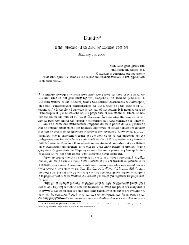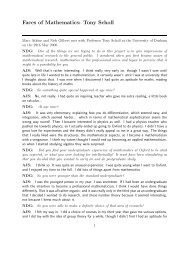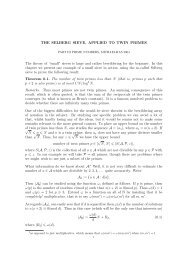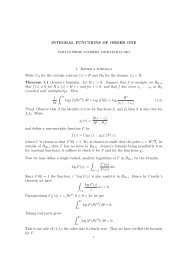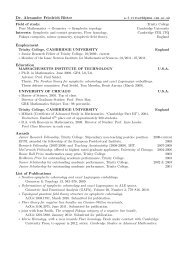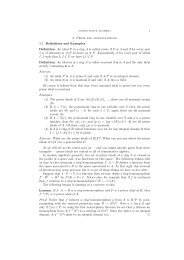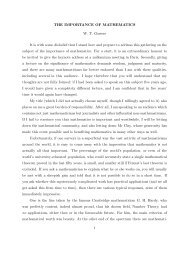Baire Category, Probabilistic Constructions and Convolution Squares
Baire Category, Probabilistic Constructions and Convolution Squares
Baire Category, Probabilistic Constructions and Convolution Squares
You also want an ePaper? Increase the reach of your titles
YUMPU automatically turns print PDFs into web optimized ePapers that Google loves.
There are several reasons for using the <strong>Baire</strong> category theorem when we<br />
seek examples of particular types of behaviour.<br />
The first is practical. Although any <strong>Baire</strong> category argument can obviously<br />
be replaced by a direct argument, if there are several properties<br />
involved, each of which involves countably many conditions the direct argument<br />
may require quite a lot of notation <strong>and</strong> careful interlocking of several<br />
inductions. Such arguments are not hard to write (<strong>and</strong> indeed may give the<br />
author some pleasure), but are may be hard to read.<br />
The second argument is that a property which holds quasi-always is, in<br />
some sense, generic. The next exercise shows that we must not press this<br />
argument too far.<br />
Exercise 2.8. The following is a well known procedure for constructing ‘Cantor<br />
sets’. Let E0 = [0, 1] <strong>and</strong> let ζ1, ζ2, ... be a sequence of real numbers with<br />
0 < ζj < 1. At the nth stage En is the union of 2 n disjoint closed intervals<br />
I(r,n) all of the same length. We define En to be the union of the 2 n+1 disjoint<br />
closed intervals formed by removing an open interval J(r,n) of length<br />
ζn times the length of the initial interval I(r,n) from the centre of I(r,n).<br />
(Thus if I(r,n) = [cr,n −δn,cr,n +δ] we take J(r,n) = (cr,n −ζnδn,cr,n +ζnδn)<br />
<strong>and</strong><br />
2<br />
En+1 =<br />
n<br />
<br />
(I(r,n) \ J(r,n).<br />
r=1<br />
(i) Explain why ζ = ∞ n=1 ζn is well defined. Show that ζ can take any<br />
value subject only to the condition 1 > ζ ≥ 0.<br />
(ii) Show that E = ∞ n=1 En is a closed nowhere dense set without isolated<br />
points. Show that E has Lebesgue measure ζ.<br />
(iii) Construct a set H ⊆ [0, 1] of first <strong>Baire</strong> category but of Lebesgue<br />
measure 1. Points in H are ‘generic in the the sense of measure theory’<br />
(almost all points in [0, 1] lie in H) but the points of [0, 1] \ H are ‘generic<br />
in the the sense of topology’ (quasi-all points in [0, 1] lie [0, 1] \ H).<br />
(iv) Construct a set P ⊆ R of first <strong>Baire</strong> category such that R \ P has<br />
Lebesgue measure zero.<br />
The third argument is that the act of seeking a <strong>Baire</strong> type proof may, by<br />
itself, suggest a new ways of looking at your problem.<br />
3 The Hausdorff metric<br />
The Hausdorff metric measures the difference between compact sets.<br />
6



